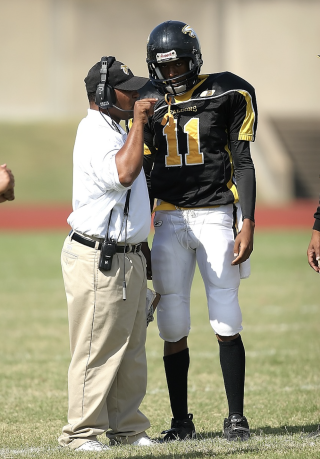Sport and Competition
The Destructive Nature of Scholastic Sports
Personal Perspective: We need to rethink the purpose and goals of youth sports.
Posted July 26, 2024 Reviewed by Davia Sills
Key points
- Organized sports offer tremendous character-building and maturational opportunities for children.
- When poorly managed, organized sports can be harmful to our youth on multiple levels.
- Much discourse is needed on the goals and management of youth sports, both in and of school.
- We should be enlisting a growing number of our youth into organized athletics rather than narrowing them down.

Not long ago, a local high school football coach, upon losing an important game, complained publicly that “his” team had not “come ready to play” and that they were a “mediocre” bunch who had not put in the work to be winners. What struck me about his comments was how similar they were to the innumerable lamentations of other youth coaches in multiple sports that I have heard through the years. If such remarks merely represent poorly thought-out sound bites, so be it, but if they reflect the beliefs of these people (and their parent institutions), we have a problem. I fear the latter.
Frankly, I’ve been shocked by, and in awe of, the rudderless ship that is American scholastic athletics (in fact, all youth athletics). I can’t discern a guiding philosophy or principle behind this juggernaut, yet we parents and taxpayers support and fund it all with nary a murmur. Well, I have a few murmurs… or at least some concerns.
The Purpose of Scholastic Athletics
What is the actual purpose of scholastic athletics? Are they solely for the nurture and promotion of the athletically gifted? Are they to distill down the madding crowds of our youth to the rare few who can qualify for full-ride collegiate scholarships (about 1 percent of all high school athletes) or the exceedingly rare few who can make it into a professional league (0.02-0.03 percent for most professional sports)?

What do the vast majority of students get out of their athletic experiences? What do we want them to get? Under the current paradigm, how well do the two match?
For example, do scholastic athletic programs promote a concept of team effectiveness and cohesion? Do they celebrate inclusiveness? Do they encourage respect for the contribution of all members? Do they help develop leadership skills in all members? Do they promote tolerance of and support for athletes of varying levels of development and skill? Do they foster a lifelong love for exercise and physical fitness? Do they promote cross-training, whole-body fitness, and injury avoidance? Do they support the emotional growth of the kids? Do they celebrate effort, resilience, grit, and determination no matter the outcomes of competitions? Will the athlete look back on their experiences with warmth and gratitude? Where does the concept of fun fit into the deal?
The Risks of Scholastic Athletics
As scholastic sports become increasingly competitive, potential harm abounds. This includes but isn’t limited to:
- The promotion of narcissism and social Darwinism
- Ego destruction by coaches or other students through bullying, belittling, blaming, and even physical abuse
- Prioritization of parental, school, or community ego fulfillment over student health and enjoyment
- Diversion of limited resources to a small pool of students
- Interference with academic development and the exploration of diverse interests
- Overspecialization of athletes with risks of burnout, repetitive use injuries, and even multiple surgeries at a young age
- Promotion of cheating, including the use of performance-enhancing drugs
- Resultant lifelong aversion to physical fitness activities
- Family stress through unrealistic parental expectations, mismatched desires, or just physical separation and time consumption
- Exploitation of disadvantaged athletes
Who’s in Charge?
In a typical program, who actually oversees the activities and behaviors of scholastic coaches, and to what guidelines are they held? How are the coaches evaluated? How often are they formally reviewed? What feedback is solicited from parents and athletes?
Is there mandatory continuing education for coaches in their respective sports as well as in the handling, nurturing, and motivating of children and adolescents? Do they receive even a modicum of psychological training? Are they well-schooled in physical conditioning, cross-training, weight training, and injury avoidance?

Cutting
We don’t cut kids from academics for lacking stellar scholastic aptitude. Is cutting a reasonable recourse for the management of the less athletically gifted? In this increasingly unhealthy society, shouldn’t we be encouraging, if not soliciting, participation in our athletic programs?
Why do we so readily separate the majority of our students from the character-building opportunities of organized athletics? Are we sure that cutting kids from sports that they enjoy doesn’t do irrevocable emotional damage or set them on a course of diminished physical activity and overall health?
What is the purpose of cutting? Is winning titles in junior high and high school critical to the schools’ missions? Should alternative athletic activities be established for those children who are cut from programs?
Extensions of the Classroom
Shouldn’t athletic courts and fields become an extension of the classroom? Shouldn’t scholastic athletics be considered an important part of the curriculum? Shouldn’t the goals and expectations of athletic programs dovetail with those of the academic, developmental, and citizenship mission? Shouldn’t such goals and expectations be planned, routinely reviewed, and overseen? Shouldn’t coaches be held to rigorous codes of ethics and behavior and stay current in their sports, physical conditioning, and the general health (mental and physical) of developing children?

Time to Discuss
It’s time for a dialogue on the purpose of American scholastic athletics. Frankly, it should be extended to all organized youth sports programs. Who do they serve? Who benefits from them? What is the net outcome of such programs with respect to youth and subsequent adult mental and physical health?
I can’t help thinking that we are mindlessly streaming in the wrong direction, captured by celebrity worship, the draw of big money, mass marketing, and unrealistic childhood fantasies of our own. Our kids are already subject to astronomical scholastic and career achievement pressures. Why do we insist on foisting impossible athletic expectations upon them? Why do we insist on accelerating their journey to adulthood with its attendant stressors and disappointments?
I may be asking a lot, but coaches often have a hold of our kids more hours a day than we or any single teacher do. A great coach in a great athletic program has a positive impact on a kid’s life that can last for decades. Ruthless systems and incompetent and mean-spirited coaches can be a threat to a child’s development.
Final note: The author participated in team sports throughout his childhood and into his 50s.
References
DiFiori,J., et al. (2014) Overuse injuries and burnout in youth sports: a position statement from the American Medical Society for Sports Medicine. British Journal of Sports Medicine. 2014 Feb;48(4):287-8. doi: 10.1136/bjsports-2013-093299.
Myer, G. Et al. (2015) Sport Specialization, Part I: Does Early Sports Specialization Increase Negative Outcomes and Reduce the Opportunity for Success in Young Athletes? Sports Health. 2015 Sep-Oct;7(5):437-42. doi: 10.1177/1941738115598747. Epub 2015 Aug 6.
Gustaffson, H., et al. (2016) Fear of failure, psychological stress, and burnout among adolescent athletes competing in high level sport. Scandinavian Journal of Science and Medicine in Sports. 2017 Dec;27(12):2091-2102. doi: 10.1111/sms.12797. Epub 2016 Nov 23.
Lipton, M. (2019) Rethinking Youth Sports. Cerebrum. 2019 Sep 1:2019:cer-09-19. eCollection 2019 Sep-Oct.
Pandya, N. (2021) Disparities in Youth Sports and Barriers to Participation. Currently Rev Musculoskelet Med. 2021 Dec;14(6):441-446. doi: 10.1007/s12178-021-09716-5. Epub 2021 Oct 8.




